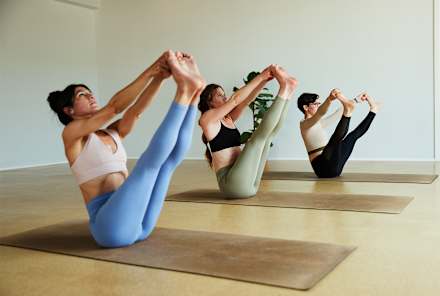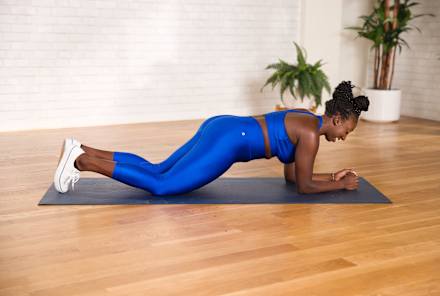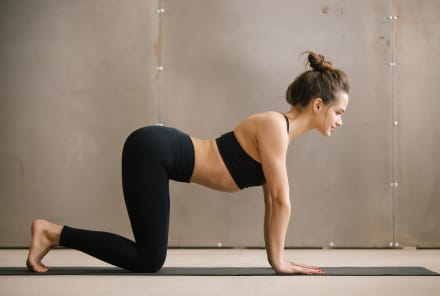Advertisement
Pilates Vs. Weight Lifting: Which Is Better For Building Muscle? Here's Our Investigation


I transitioned to weight training after five years of devoted Pilates practice and even more years immersed in the disciplined world of athletic dance. Initially, the shift felt daunting—a new routine, an unfamiliar form of exercise—but as I grew accustomed to this fresh challenge, I found myself more content with my workouts than I had ever been.
That was a year and a half ago. Today, I’m still going strong—literally and figuratively—feeling more empowered and confident in how my body looks, feels, and performs. But it got me thinking: why did weight training succeed where Pilates seemed to fall short? Why couldn’t I reach my goals through Pilates alone?
The conversation around Pilates versus weight training is far from new on our platform; it’s a topic that regularly surfaces on the mindbodygreen podcast. Given its importance, we decided it was time for an in-depth exploration. Ahead, we'll dive into the fundamental differences between Pilates and weight training, why one might not suffice for achieving peak muscle gains, and how muscle mass plays a critical role in overall health and longevity.
Meet the experts
Nichele Cihlar
Personal trainer certified in USAWeightlifting, CrossFit L1, Pilates Reformer &Mat, and 500RYT Yoga instructor. She’s also the Director of Training for GORUCK.
Chelsea Stewart
Certified Pilates instructor and founder of HAVN Hot Pilates.
Ali Novinsky, M.D.
Board-certified obesity medicine physician and CEO of The Fit Collective.
JJ Virgin
Celebrity nutritionist, personal trainer, New York Times bestselling author, founder, and host of the Well Beyond 40 podcast.
What Pilates can do
We often refer to Pilates as a single entity, but in reality, it's a diverse discipline with various forms. For instance, there’s mat Pilates, where you primarily use your body weight and accessories like 1 to 2-pound ankle weights or Pilates balls. Then there’s reformer Pilates, which introduces springs for added resistance, some of which are lighter than others.
When you look at the popular Pilates trainers online, it’s hard not to notice their long, lean, and exceptionally toned muscles. Anyone claiming that Pilates can’t build muscle is clearly misinformed—let’s clear that up right now.
In fact, there are plenty of reasons to include Pilates in your fitness routine. Some of the key benefits include:
- Increased flexibility
- Strengthening of small stabilizing muscles
- A gentle reintroduction to fitness post-injury
- Injury prevention, thanks to improved flexibility and stabilizing muscle work
- Significant abdominal muscle training
- Enhanced posture
However, we must acknowledge an important truth: "Pilates has many benefits, but it will not build the same amount of muscle mass as weight lifting," explains Nichele Cihlar, a certified trainer in both Pilates and weight lifting.
Why is that? According to Cihlar, "You have to increase exercise volume and intensity over time to increase muscle mass."
So yes, if you start Pilates tomorrow, you can definitely gain muscle and strength over time. However, experts agree that there’s a limit to muscle gains in most traditional Pilates settings due to the lack of progressive intensity. Think of it like a ceiling—one that can only rise if you continue to add weight and resistance.
Summary
What weightlifting can do
Now that we've covered the basics of Pilates, let's explore the standout advantages of weight training in comparison. Here are a few key benefits:
- Greater potential for muscle growth: Weight training offers more opportunities to increase muscle volume, allowing for significant gains in strength and size.
- Targeting fast-twitch muscle fibers: These fibers, which are crucial for quick, powerful movements, tend to diminish as we age1 quicker than slow-twitch fibers. Weight training effectively engages and preserves them.
- Potentially better for weight loss: Weight training can be more effective for shedding pounds, partly due to its impact on muscle mass and metabolism.
- Boosts metabolic rate: By increasing muscle mass, weight training elevates your metabolic rate, which can aid in long-term weight management.
It's important to mention that many weight-lifting workouts also engage your stabilizing muscles, albeit in a different manner than Pilates.
Consider doing squats with a heavy barbell on your shoulders—maintaining balance and stability during this exercise requires those small, often overlooked muscle fibers to work just as hard as your larger muscle groups.
Summary
Yes, you can (and arguably, should) add weights to your Pilates routine
There’s an often-overlooked middle ground—weighted Pilates—which many trainers consider crucial for muscle gains as you advance in your Pilates practice.
“Integrating weight training into your Pilates routine is extremely important. Simply add weights, increase resistance, and use props like a Pilates ring or even weighted bangles,” advises Chelsea Stewart, Pilates instructor and founder of HAVN Hot Pilates.
“The added weight provides a two-for-one workout, enabling your body to grow stronger through progressive overload with the continuous and varied use of weights,” she explains.
This approach can serve as a bridge between weight lifting and Pilates, offering an ideal solution for those wanting to intensify their Pilates routine and achieve greater muscle gains.
Nevertheless, traditional Pilates typically involves lighter weights and higher repetitions. While this approach can contribute to increased strength, trainers generally recommend using heavier weights with fewer repetitions (around 8-10) for optimized muscle growth. This is why weight training is often preferred for achieving more significant muscle development.
Think about it like this: To get your maximum muscle gains, you'll have to lift weights to failure—which doesn't typically take place in a Pilates class.
How muscle mass contributes to longevity
“As we age, the importance of weight training cannot be overstated,” says board-certified obesity medicine physician Ali Novinsky, M.D.
As we age, the importance of weight training cannot be overstated.
“With each passing year, our muscle mass naturally declines, affecting strength, balance, and overall mobility,” she explains. Engaging in regular weight training and building muscle while you’re young helps counteract this decline.
“This means everyday activities—whether it’s carrying groceries, climbing stairs, or playing with grandchildren—become easier and more enjoyable,” Novinsky adds.
On a previous mindbodygreen podcast episode, celebrity nutritionist and personal trainer JJ Virgin related this idea to that of a retirement fund.
“I would argue that we should all aim to build as much skeletal muscle as possible, like stuffing money into a high-interest retirement account,” Virgin suggests. “The more we invest now, the more we’ll have to benefit from later.”
Summary
Why you should do both
To wrap up, here’s what we’ve established:
- Weight training is generally more effective for muscle volume gain compared to Pilates.
- Building muscle now provides long-term benefits.
- Flexibility and stabilizing muscle training contribute to lifelong mobility.
- Pilates and similar exercises help prevent injury & aid in injury recovery.
As Virgin aptly put it: “It’s not a religion. Let’s just follow the science.”
It’s not a religion. Let’s just follow the science.
This means you don’t need to commit exclusively to one form of exercise. While weight training is often better for muscle mass, incorporating Pilates, yoga, and other slow-twitch muscle workouts is beneficial. Neglecting flexibility or solely focusing on fast-twitch muscle workouts like weight training, sprints, etc., can hinder your mobility, too. Simply put, you need both—Pilates satisfies the slow-twitch box, while weight training checks the other.
It’s like eating a balanced diet—your best bet is to nurture all different kinds of foods—fruits, vegetables, legumes, seeds, etc., but also make protein a priority as you should weight training.
Cihlar recommends: “I suggest weight training at least three times a week, targeting all major muscle groups, even if each session is just 30 minutes. Complement this with Pilates, rucking, and yoga to keep your routine diverse and engaging.”
Ultimately, the key is to enjoy your workout. Exercise isn’t just about weight loss or toning; it’s about fostering a longer, healthier life. Everything else is an added benefit.
Helpful resources to get you started
We’ve covered the topic of weight training and muscle-building a lot, so here are some helpful links to you start (or inspire you to continue) your muscle-building journey.
- My Experience Switching From Pilates To Weight Training + Tips
- A Complete Guide For Strength-Training At Home + 4-Part Plan To Get Started
- How To Work Cardio Into Your Muscle-Building Workout Routine
- Yes, Eating More Protein Can Help You Lose Fat & Build Muscle — Here's How
- Protein Needs For Women: How Much Is Enough — And What's Too Much?
- Why You Need To Incorporate Fast-Twitch Exercises Into Your Routine STAT
The takeaway
The experts have spoken and concluded that weight training is more effective than Pilates for muscle growth, but combining it with flexibility exercises like yoga and Pilates is even better for long-term mobility and overall health.
If you want to dive deeper into the why behind building muscle for longevity, tune into JJ Virgin’s full interview on the mindbodygreen podcast. You can watch on YouTube or listen in on Apple Podcasts.
Watch Next
Enjoy some of our favorite clips from classes
Enjoy some of our favorite clips from classes
What Is Meditation?
Mindfulness/Spirituality | Light Watkins
Box Breathing
Mindfulness/Spirituality | Gwen Dittmar
What Breathwork Can Address
Mindfulness/Spirituality | Gwen Dittmar
The 8 Limbs of Yoga - What is Asana?
Yoga | Caley Alyssa
Two Standing Postures to Open Up Tight Hips
Yoga | Caley Alyssa
How Plants Can Optimize Athletic Performance
Nutrition | Rich Roll
What to Eat Before a Workout
Nutrition | Rich Roll
How Ayurveda Helps Us Navigate Modern Life
Nutrition | Sahara Rose
Messages About Love & Relationships
Love & Relationships | Esther Perel
Love Languages
Love & Relationships | Esther Perel











